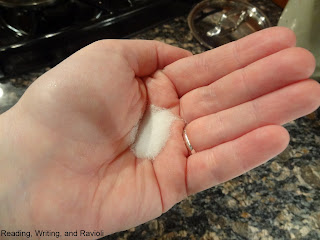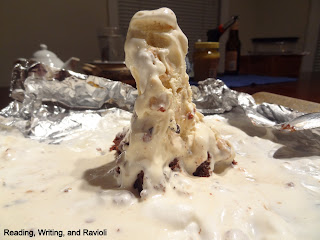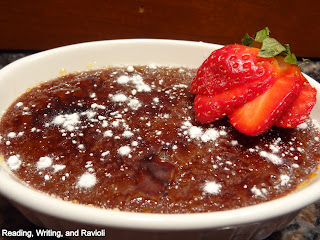Flavored and infused oils can be used to dress up a simple salad, add a splash of flavor to chicken or fish, or add a little kick to a dish of pasta, and they're quite easy to make and store. Ingredients like fresh herbs, garlic, and lemon zest are popular flavoring choices and lightly flavored oils absorb these flavors very well. There are two main methods for flavoring oils: hot oil infusion and cold oil infusion. Hot oil infusion (the method I prefer) involves heating the oil, adding the flavoring ingredient to the hot oil, and allowing it to steep until the desired flavor is reached. Cold oil infusion takes longer, as the oil and flavoring ingredient mixture must rest for a few weeks for full flavor to be reached.
Oils to use for flavoring and infusing
You want to use a lightly flavored oil when making infused oils because any strong flavor already present in the oil will likely overpower the flavoring ingredient that you want to add. I highly recommend using light or extra-light olive oil (extra virgin olive oil is already flavorful in and of itself, so it doesn't absorb and highlight other flavors as well). These lighter olive oils have a delicate flavor, smooth texture, and they work well on pretty much any food.
Flavoring ingredients
- Fresh herbs (basil, rosemary, or a mix of various herbs are popular choices)
- Fresh garlic
- Sun-dried tomatoes
- Fresh or dried peppers
- Lemon, lime, or orange zest
- Ginger
- Lavendar
These are just a few of the more popular flavoring ingredients, and I recommend trying one of these first because they're the easiest to work with. Fresh herbs should be chopped up or crushed/bruised first to make it easier to extract their flavors, and any larger ingredient, like garlic cloves or sun-dried tomatoes, should be finely chopped to help them release their flavors. You can always strain the olive oil once it's finished and add in whole herb leaves or whole chunks of an ingredient if you want to "make it pretty" (flavored oils are great housewarming gifts, by the way), or simply leave the chopped/bruised ingredients in it. Certain ingredients will actually color the oil—fresh basil makes the oil slightly green, sun-dried tomatoes make the oil slightly red—which is perfectly normal, and actually quite nice looking.
Oil-to-Flavoring Ingredient Ratio
There isn't really a precise measurement for oil or flavorings—making flavored oils is all about getting the exact flavor that
you want. You need a good handful of any flavoring ingredient to achieve any sort of flavor, but it's up to you to decide how much. For the basil oil pictured in this post, I used one whole package (approx. 2 oz.) fresh basil, cut chiffonade (long, thin strips), in 1 cup of oil, and it created a strong, clean basil flavor that was just right. Measuring the oil is all a matter of how much you want to end up with, but you need to create a balance between the oil and the flavoring. You need to have more oil than flavoring, and I recommend pouring out the amount of oil you want to end up with, and add flavoring as you see fit. You can always add more later to increase the flavor.
 |
| Basil Oil (1, approx. 2 oz. package basil, cut chiffonade, and approx. 1 cup light olive oil)
|
Hot Infusion Method
In a small-to-medium pot, heat the oil over medium heat until it reaches approx. 185*F. Do not turn the heat up too high or let the oil heat up for a long time, because it can burn, which absolutely destroys the flavor. Once the oil is heated through, add your flavoring ingredient, lower the heat, and let the mixture steep for a few minutes (when I tossed the basil in, it sizzled up immediately and sounded like it was frying, but the activity gradually decreased as the mixture cooled—all of this is normal). Turn off the heat and let the mixture continue to steep until the oil has reached room temperature. Pour the oil into a container with a tight-fitting lid, seal it, and let it chill in the refrigerator overnight. Once cooled and rested overnight, taste the oil to see if the desired flavor has been reached. If it's too strong, add a little more oil. If the flavor isn't strong enough, gently rewarm the oil and add more flavoring. The flavors can take a few days to develop (in fact, the flavor will get stronger over the first few days), but this method is the quickest and easiest way to create a delicious flavored oil (my oil was already tasting great the day I made it).
Cold Infusion Method
In a container with a tight-fitting lid, add the flavoring ingredient, then pour the desired amount of oil over top, seal the container, and keep it in the fridge. Let the mixture steep for at least 2 weeks, then strain out the flavoring ingredient. If desired, add fresh pieces of the flavoring ingredient to the oil for a nicer presentation.
*Important note: Flavored oils are a potentially hazardous food, meaning that, if not properly stored or used within a certain amount of time, they have the potential to go rancid and possibly make you sick. Flavored and infused oils should be stored in the fridge (the oil will solidify to a degree when cold, so be sure to set them out and let them rise to room temperature before using). They should be used within 10-14 days of being made. Do not keep them in a metal container, because it can affect their flavor. If you're unsure about how an ingredient with react when it's infused in oil, look it up before using it as a flavoring.












































